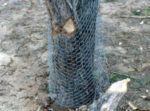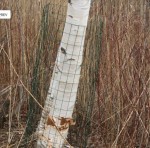Here are three things you don’t usually find together. A scientific report about beavers in the news, a Dutch account of adorable orphaned beavers, and a city in Rhode Island that has decided to use huge metal cages to discourage beavers. One of the three stories is incomprehensible gibberish – and believe you me it ain’t the Dutch.
Town bringing heavy cages into fight against beavers
 CUMBERLAND – From the Monastery to Diamond Hill Park, and numerous other waterways across town, local beavers appear undeterred in their path of destruction, causing downed trees and flooding as they move from place to place.
CUMBERLAND – From the Monastery to Diamond Hill Park, and numerous other waterways across town, local beavers appear undeterred in their path of destruction, causing downed trees and flooding as they move from place to place.
Now town workers, upping their game after a failed experiment with smaller “beaver deceivers,” or wire devices meant to allow water through and prevent beavers from building dams, are installing larger metal cages at strategic locations.
Highway Supt. Frank Stowik said a friend gave him the cages, and they’ve been reinforced with screens that he said are impossible to break through by jumping on them. Three are being installed at the Monastery, he said, and workers are planning to install more.
 Um, did the ‘friend’ who gave you the cages borrow them from the BDSM club he visits on tuesdays when the wife’s playing bridge? I thought so. How exactly are they supposed to work. I realize you and the boys had fun jumping on them but what are they supposed to do exactly?
Um, did the ‘friend’ who gave you the cages borrow them from the BDSM club he visits on tuesdays when the wife’s playing bridge? I thought so. How exactly are they supposed to work. I realize you and the boys had fun jumping on them but what are they supposed to do exactly?
A smaller contraption was vandalized at the Monastery last year, he said, but these larger devices will hopefully prove more effective.
There are now discussions between some Land Trust members and town officials about potential solutions through trapping, said Murray. Past efforts at taking stronger measures were met with strong resistance, he said, so they’ll exercise caution moving forward.
Say no more. I understand what this is completely. We’ve seen it a million times before. Some compassionistas Save-the-beaver types stopped you from trapping and made you try a ‘beaver deceiver’. So you put a piece of dental floss in chicken wire and called it one because who can stop you? And then it didn’t work (surprise!) and you are bring in those huge cages leftover from the set of ‘shark week’ so when they fail you can say with a straight face,
“We tried using humane methods and they just didn’t work. Now we have to kill them”.
You’re working very hard to not succeed. I understand how this works. This ain’t my first rodeo.
New coverage of the Stirling study now in Science News 
Study: Beavers Could Help Curb Soil Erosion, Clean Up Polluted Rivers
Led by University of Exeter’s Professor Richard Brazier, the study surveyed sediment depth, extent and carbon/nitrogen content in a sequence of beaver pond and dam structures in South West England, where a pair of Eurasian beavers were introduced to a controlled 1.8 ha site in 2011.
 “The animals built 13 dams, slowing the flow of water and creating a series of deep ponds along the course of what was once a small stream,” the scientists explained.
“The animals built 13 dams, slowing the flow of water and creating a series of deep ponds along the course of what was once a small stream,” the scientists explained.
“We measured the amount of sediment suspended, phosphorus and nitrogen in water running into the site and then compared this to water as it ran out of the site having passed through the beavers’ ponds and dams.. We also measured the amount of sediment, phosphorus and nitrogen trapped by the dams in each of the ponds.”
The results showed the 13 beaver dams had trapped 101.53 tons of sediment, 70% of which was soil, which had eroded from ‘intensively managed grassland’ fields upstream. Further investigation revealed that this sediment contained 15.9 tons of nitrogen and 0.91 tons of phosphorus, which are nutrients known to create problems for the wildlife in rivers and streams and which also need to be removed from human water supplies to meet drinking-quality standards.
Oh yes they did. Thank you for paying attention. Now if you could just send the results to the idiots in Cumberland and get them to stop “playing cages” long enough to realize that a LAND TRUST should value you its beavers we’d be in business.
The final act of this three-part drama comes from our friends in Belgium.Jorn Van Den Bogaert posted in the beaver management forum that his team had come across a nursing female beaver who had been hit by a car, They opened the lodge and rescued the kits and were asking how to care for them. All the right people helped and those kits are getting a good second chance as we speak. This was on Dutch TV last night, and even though you probably won’t understand it, you have to watch it because it is the best thing you will ever see.



 The study, undertaken by scientists at the University of Exeter using a captive beaver trial run by the Devon Wildlife Trust, has demonstrated the significant impact the animals have had on reducing the flow of tonnes of
The study, undertaken by scientists at the University of Exeter using a captive beaver trial run by the Devon Wildlife Trust, has demonstrated the significant impact the animals have had on reducing the flow of tonnes of  Pewaukee Lake is a five mile fishing spot in Wisconsin. It is best known for it’s inland sailboat races. Not remote in any way, it is a popular summer visit for Milwakee residents, who once upon a time depended on ice harvested from its shores.
Pewaukee Lake is a five mile fishing spot in Wisconsin. It is best known for it’s inland sailboat races. Not remote in any way, it is a popular summer visit for Milwakee residents, who once upon a time depended on ice harvested from its shores.





 It happened last night around 7:30 while he and his crew were monitoring a bridge about 10 kilometres west of Merritt, where you’ve likely heard there’s been flooding.
It happened last night around 7:30 while he and his crew were monitoring a bridge about 10 kilometres west of Merritt, where you’ve likely heard there’s been flooding. Beaver supporters had an exciting festival planning meeting yesterday. I’m starting to feel that the year our event is going to be really dynamic. There will be more things for kids to do and more exhibitors and more excitement that we’ve ever had. FRo brought her sketch for the curtain panels kids will be painting, which will be wonderful and useful to us for years to come. (I’m thinking they’ll make an awesome backdrop for the stage). Kids will get to their own chalk alongside Amy on the ‘chalk walk’. And Amy’s unfolding art will dominate in the center all day long.
Beaver supporters had an exciting festival planning meeting yesterday. I’m starting to feel that the year our event is going to be really dynamic. There will be more things for kids to do and more exhibitors and more excitement that we’ve ever had. FRo brought her sketch for the curtain panels kids will be painting, which will be wonderful and useful to us for years to come. (I’m thinking they’ll make an awesome backdrop for the stage). Kids will get to their own chalk alongside Amy on the ‘chalk walk’. And Amy’s unfolding art will dominate in the center all day long.






































